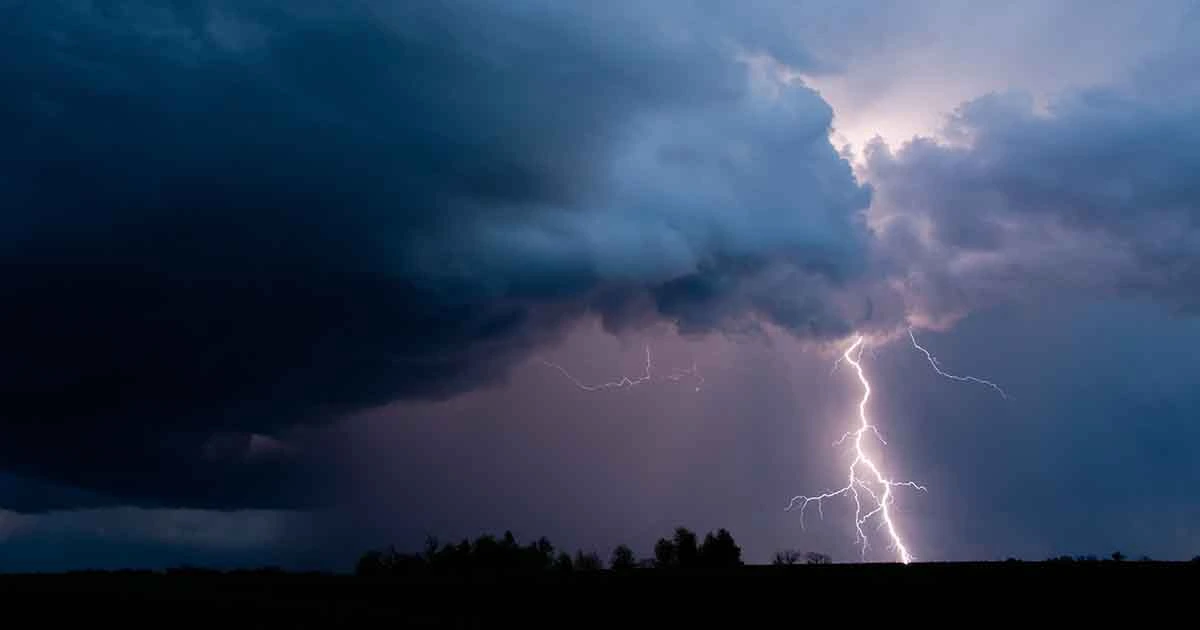
Thunderstorms are one of nature’s most awe-inspiring phenomena, captivating our attention with their dramatic displays of lightning and thunder. These powerful storms can develop rapidly, bringing with them a mix of excitement and caution. In this blog, we will explore a variety of fascinating facts about thunderstorms, from how they form and the different types that exist, to their impact on the environment and safety tips for when they strike. Whether you’re a weather enthusiast or simply curious about the forces of nature, join us as we delve into the electrifying world of thunderstorms!
Thunderstorms are Common: Every day, around 40,000 thunderstorms occur worldwide, showcasing the dynamic and ever-changing nature of our atmosphere. These storms can vary significantly in intensity and duration, from brief summer showers to severe storms that can last for hours. The frequency of thunderstorms is particularly high in tropical regions, where warm, moist air is prevalent. This high occurrence rate contributes to various weather patterns and plays a crucial role in the global climate system.
Lightning is Hotter than the Sun: A lightning bolt can reach temperatures of about 30,000 Kelvin (53,540 degrees Fahrenheit), significantly hotter than the surface of the sun, which averages around 5,500 degrees Celsius (9,932 degrees Fahrenheit). This extreme heat is generated when the electrical discharge of lightning rapidly heats the surrounding air, causing it to expand explosively. The intense heat also contributes to the bright flash of light we see during a thunderstorm, making lightning one of nature’s most powerful phenomena.
Thunder is the Sound of Lightning: Thunder is created when lightning heats the air so quickly that it expands explosively, generating sound waves. The rapid expansion of heated air creates a shock wave that travels through the atmosphere, producing the rumbling sound we hear. The time delay between seeing the lightning and hearing the thunder can be used to estimate the distance of the storm; for every five seconds between the flash and the sound, the storm is approximately one mile away.
Lightning Strikes the Earth Often: Lightning strikes the Earth about 100 times every second, which amounts to roughly 8 million strikes a day. This frequent occurrence is a result of the electrical buildup within storm clouds, where particles collide and generate static electricity. When the electrical potential becomes strong enough, it discharges as lightning. These strikes can have serious implications, causing fires, power outages, and even fatalities if safety precautions are not taken.
Thunderstorms Need Three Ingredients: To form, thunderstorms require three essential ingredients: moisture, unstable air, and a lifting mechanism. Moisture is needed to provide the water vapor that condenses into clouds and precipitation. Unstable air, which is warmer at the surface and cooler aloft, allows for the rising of air parcels, leading to cloud formation. A lifting mechanism, such as heat from the sun or a weather front, initiates the upward movement of air, setting the stage for thunderstorm development.
Single-Cell Thunderstorms: Single-cell thunderstorms, also known as pulse storms, are small, short-lived storms that usually last about 30 minutes. They are most common in the summer months when the atmosphere is warm and humid. These storms typically produce brief heavy rain, occasional lightning, and sometimes small hail. While they can be intense, they are generally not severe and tend to dissipate quickly as the conditions that support them change.
Multi-Cell Thunderstorms: Multi-cell thunderstorms consist of several individual storm cells, each at different stages of development, which can last for hours. These storms are often organized into clusters or lines and can produce heavy rain, strong winds, and hail. The interaction between the cells allows for the continuous development of new storms while older ones dissipate, leading to prolonged periods of precipitation and potential severe weather.
Supercell Thunderstorms: Supercells are the most severe type of thunderstorm and are characterized by a rotating updraft known as a mesocyclone. These storms can produce extreme weather phenomena, including tornadoes, large hail, and damaging winds. Supercells can last for several hours and are known for their potential to cause significant destruction. The unique structure of supercells allows them to maintain their intensity and organization, making them a focus of meteorological research.
Squall Lines: Squall lines are long lines of thunderstorms that can stretch for hundreds of miles. These formations often develop ahead of a cold front and can produce strong winds, heavy rain, and severe weather conditions. Squall lines can be particularly dangerous due to their ability to generate widespread wind damage and flash flooding. They can also produce severe thunderstorms with hail and tornadoes along their leading edge.
Cloud-to-Ground Lightning: Cloud-to-ground lightning is the most dangerous type of lightning, striking from the cloud down to the ground. This type of lightning accounts for the majority of lightning-related injuries and fatalities, as it poses a direct threat to people and structures. The electrical discharge can cause fires, power outages, and significant property damage. Safety measures, such as seeking shelter indoors during a thunderstorm, are crucial to avoid the risks associated with cloud-to-ground lightning.
In-Cloud Lightning: Most lightning occurs within clouds and is not visible from the ground. This type of lightning is often referred to as intra-cloud lightning and can occur between different parts of the same cloud or between multiple clouds. Intra-cloud lightning is responsible for the bright flashes of light that can illuminate the sky during a storm. While this type of lightning is not as dangerous as cloud-to-ground lightning, it still indicates the presence of strong electrical activity within the storm, which can lead to severe weather conditions.
Heat Lightning: Heat lightning is actually regular lightning from a distant storm that is too far away to hear the accompanying thunder. This phenomenon often occurs on warm summer nights, leading to the perception that it is a unique type of lightning. Although it may appear harmless, heat lightning can indicate that a thunderstorm is nearby, and the weather can change rapidly. It serves as a reminder to remain vigilant about potential storms, even if the lightning appears distant.
Lightning Can Strike Twice: Contrary to popular belief, lightning can strike the same place multiple times, especially tall structures like skyscrapers, radio towers, and trees. This is due to the fact that these structures provide a pathway for the electrical discharge to reach the ground. For example, the Empire State Building is struck by lightning around 20 to 25 times each year. Understanding this phenomenon highlights the importance of lightning protection systems for tall buildings and the need for safety precautions during storms.
Seek Shelter Indoors: The safest place during a thunderstorm is indoors, away from windows and doors. Staying inside a sturdy building protects individuals from lightning strikes, strong winds, and flying debris. It is advised to avoid using electrical appliances and to stay away from plumbing fixtures, as water can conduct electricity. Awareness of safety protocols during thunderstorms is essential to minimize the risk of injury or damage.
Avoid Water: Water conducts electricity, making it dangerous to be in or near water during a thunderstorm. Activities such as swimming, bathing, or using plumbing fixtures should be avoided when storms are nearby. This is particularly important in areas prone to lightning strikes, as being in water can increase the risk of electrical shock. Staying dry and indoors is the best strategy to ensure safety during a thunderstorm.
Stay Away from Trees: Trees can attract lightning, making it unsafe to stand under them during a storm. When lightning strikes a tree, it can cause the tree to splinter or explode, posing a risk to anyone nearby. Additionally, the ground can become electrified around the tree, increasing the danger of being in close proximity. Seeking shelter in a sturdy building or a vehicle is a safer option than staying near trees during a thunderstorm.
Unplug Electronics: To protect electronic devices from power surges caused by lightning strikes, it is advisable to unplug them during a thunderstorm. Power surges can damage sensitive electronics, leading to costly repairs or replacements. Using surge protectors can also help safeguard devices, but unplugging them is the most effective way to ensure their safety. Taking these precautions can prevent significant disruptions and financial losses due to storm-related electrical issues.
They Bring Rain: Thunderstorms are a major source of rain, which is essential for plants and animals. The precipitation from thunderstorms can help replenish groundwater supplies, support agriculture, and maintain ecosystems. However, the intensity of rainfall during thunderstorms can vary, leading to beneficial soaking rains or potentially hazardous flash flooding. Understanding the role of thunderstorms in the water cycle is crucial for managing water resources and addressing agricultural needs.
They Can Cause Flooding: Heavy rain from thunderstorms can lead to flash flooding, especially in urban areas where water drainage systems may be overwhelmed. Flash floods can occur suddenly, posing significant risks to life and property. It is important for individuals to be aware of their surroundings during thunderstorms and to heed any flood warnings issued by local authorities. Preparedness and awareness can help mitigate the dangers associated with flooding.
They Help Balance the Atmosphere: Thunderstorms play a vital role in balancing the Earth’s atmosphere by redistributing heat and moisture. The updrafts within thunderstorms transport warm air upward, while downdrafts bring cooler air down, contributing to atmospheric circulation. This process helps regulate temperature and humidity levels, which are essential for maintaining stable weather patterns. Understanding the role of thunderstorms in the climate system highlights their importance beyond just precipitation.
They Produce Nitrogen Compounds: Lightning helps convert nitrogen in the atmosphere into compounds that plants can use for growth. The intense heat from lightning causes nitrogen gas (N2) to react with oxygen, forming nitrogen oxides (NOx). These compounds eventually fall to the ground with rain, enriching the soil and promoting plant growth. This natural process is a key component of the nitrogen cycle, demonstrating the interconnectedness of weather phenomena and ecological health.
The Sound of Thunder Travels Slowly: Thunder travels at the speed of sound, which is significantly slower than the speed of light. This is why we see the flash of lightning before we hear the thunder. The speed of sound in air is approximately 343 meters per second (1,125 feet per second), while light travels at about 299,792 kilometers per second (186,282 miles per second). This difference in speed allows us to estimate the distance of a thunderstorm; for every five seconds between the flash of lightning and the sound of thunder, the storm is roughly one mile away. This phenomenon not only provides a practical way to gauge the storm’s proximity but also emphasizes the distinct nature of light and sound as they travel through the atmosphere.
Thunderstorms Can Occur in Winter: While less common, thunderstorms can indeed happen in winter, particularly during strong cold fronts or when warm, moist air collides with colder air masses. These winter thunderstorms can produce snow, sleet, or freezing rain, and are often referred to as “thundersnow.” Although they may not be as frequent as summer thunderstorms, winter thunderstorms can still be intense and pose risks such as reduced visibility and hazardous travel conditions. Understanding that thunderstorms can occur in any season helps highlight the variability of weather patterns and the need for preparedness year-round.
Frequently Asked Questions about Thunderstorms:
1. What causes thunderstorms?
Thunderstorms are caused by a combination of moisture, unstable air, and lift. When warm, moist air rises, it cools and condenses to form clouds. If the air is unstable, meaning warmer air is below cooler air, it can lead to the development of cumulonimbus clouds, which are associated with thunderstorms. Additionally, factors such as weather fronts, sea breezes, and mountain ranges can provide the necessary lift to trigger a thunderstorm.
2. What are the different types of thunderstorms?
There are several types of thunderstorms, including:
- Single-cell thunderstorms: These are small and short-lived, typically lasting about an hour. They are characterized by one updraft and are often seen in warm, humid environments.
- Multi-cell thunderstorms: These consist of a cluster of cells that can last for several hours. They can produce severe weather, including heavy rain and hail.
- Supercell thunderstorms: These are the most severe type and are characterized by a rotating updraft called a mesocyclone. Supercells can produce tornadoes, large hail, and intense rainfall.
- Severe thunderstorms: These are defined by the National Weather Service as storms producing hail of at least 1 inch in diameter, wind gusts of 58 mph or greater, or a tornado.
3. How can I stay safe during a thunderstorm?
To stay safe during a thunderstorm, follow these guidelines:
- Seek shelter: Move indoors and stay away from windows and doors. If you’re outside, find a sturdy building or vehicle.
- Avoid electrical appliances: Unplug devices and avoid using wired electronics to reduce the risk of electric shock from lightning.
- Stay informed: Keep track of weather updates through reliable sources such as weather apps or local news.
- Wait it out: Remain indoors for at least 30 minutes after the last clap of thunder to ensure the storm has passed.
4. What is lightning, and how does it occur?
Lightning is a discharge of electricity that occurs during a thunderstorm. It happens when there is a buildup of electrical charges within clouds. As the storm develops, particles within the cloud collide and create static electricity. When the difference in charge becomes too great, a discharge occurs, resulting in a flash of lightning. This can happen within a cloud, between clouds, or between a cloud and the ground.
5. What is the difference between thunder and lightning?
Lightning is the visible electrical discharge that occurs during a thunderstorm, while thunder is the sound produced by the rapid expansion and contraction of air surrounding the lightning bolt. The speed of light allows us to see the lightning almost instantly, while sound travels more slowly, which is why we hear thunder after seeing lightning.
6. Can thunderstorms cause tornadoes?
Yes, thunderstorms, particularly supercell thunderstorms, can produce tornadoes. Tornadoes form when there is a combination of wind shear (changes in wind speed and direction with height) and the rotation of a supercell. Not all thunderstorms produce tornadoes, but those that do are often severe and can lead to significant damage.
7. How can thunderstorms affect the environment?
Thunderstorms can have various effects on the environment, including:
- Rainfall: They can bring much-needed rain to dry areas, but excessive rainfall can lead to flooding.
- Soil erosion: Heavy rains can wash away soil, affecting agriculture and natural landscapes.
- Wildfires: Lightning strikes from thunderstorms can ignite wildfires in dry areas.
- Air quality: Thunderstorms can help clear pollutants from the air, but they can also contribute to the formation of ozone at ground level.
8. What should I do if I see a storm approaching?
If you see a storm approaching, it’s important to take precautions:
- Monitor the weather: Use a weather app or radio to stay updated on the storm’s progress.
- Prepare your home: Secure outdoor items that could become projectiles in high winds.
- Plan for power outages: Have flashlights, batteries, and essential supplies ready in case of an outage.









